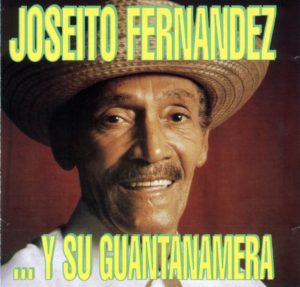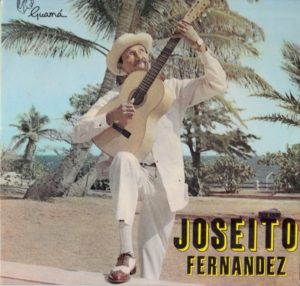 LA “GUANTANAMERA” Y JOSEITO FERNÁNDEZ, ESA IMAGEN SIMBOLICA DE LA MUSICA CUBANA. VIDEOS
LA “GUANTANAMERA” Y JOSEITO FERNÁNDEZ, ESA IMAGEN SIMBOLICA DE LA MUSICA CUBANA. VIDEOS
Joseíto Fernández nació el 5 de septiembre de 1908, en una casa en la calle Gervasio entre Estrella y Maloja en el barrio Los Sitios de la capital. Allí vivió y creó hasta sus últimos días, brillando no solo por su genio artístico sino también por su humildad, decencia y trato exquisito hacia sus vecinos y niños del vecindario.
A los 12 años, ya se estaba serenatando con sus amigos en el vecindario. Luego, mientras se ganaba la vida como zapatero y sin tener estudios musicales académicos, formó tríos y sextetos de aficionados hasta que comenzó a cantar en varias orquestas típicas.
Su voz armoniosa, timbre exquisito, afinación y talento artístico pronto le valieron el apodo de El Rey de la Melodía y la simpatía y admiración de los directores de los grupos musicales que lo hicieron parte de sus nóminas.
Es escritor de canciones conocidas, como “Elige tú, que canto yo”, “Amor de madre”, “Demuéstrame tú” y “Así son, boncó”, así como la más famosa “Guajira Guantanamera”.
Su catálogo de autores tiene una gran cantidad de sones, guajiras y guarachas, pero el guajira-hijo La Guantanamera fue, sin lugar a dudas, el que lo llevó al estrellato.
El propio autor dijo que la melodía surgió del calor de una pasión amorosa que despertó una bella mujer de la tierra de Guaso, una asistente puntual a todas sus presentaciones; y no se puede hablar de Joseíto sin mencionar esta canción.
Creada en 1928, no fue hasta casi una década después de que la pieza antológica ganó popularidad cuando el maestro Alejandro Riveiro comenzó a tocarla al final de las presentaciones de su orquesta. Mientras el conjunto tocaba los acordes de la melodía pegadiza, Joseíto improvisó estrofas de diez líneas sobre las cualidades de las mujeres locales.
En 1943, La Guantanamera llegó a la radio cuando Joseíto fue contratado para actuar en un programa de radio CMQ que se especializó en dar las noticias más impactantes de la crónica roja en forma de décimas compuestas por un poeta arrepentido. Día tras día, durante 14 años, el evento del día salió al aire con los hechos más dramáticos del evento diario marcado por el coro de la canción.
Sin embargo, La Guantanamera que ha dado la vuelta al mundo, la que contiene los versos simples de José Martí, nació el 8 de junio de 1963 cuando fue interpretada en Nueva York por el cantante folk norteamericano Pete Seeger, según la versión que el músico Julián Orbón lo hizo en los años 50.
A pesar de la fama ganada, José Fernández Díaz, Joseíto, nunca abandonó su proverbial humildad y para que los vecinos pudieran verlo, sentado en la esquina de su puerta, saboreando el café de la mañana en un frasco de esmalte antes de irse a trabajar.
Cuarenta años después de la desaparición física de este distinguido artista habanero, su obra y su memoria aún se perpetúan en la Casa de Cultura de Centro Habana que lleva su nombre y en su propia casa, convertida en museo. Por lo tanto, lo será, durante mucho tiempo por venir, mientras una Guajira Guantanamera continúe viajando por el mundo en las voces de los cantantes más eminentes.
El 11 de octubre de 1979 fue un día oscuro para la cultura cubana porque falleció Joseíto Fernández, una figura icónica del catálogo musical del archipiélago antillano y autor de La Guantanamera, esa pieza emblemática que ha viajado por todo el mundo.
Composiciones seleccionadas
“Tu Misma Me Acostumbraste,” Joseíto Fernández (w&m)
“Mi Madre y Mi Tierra,” Joseíto Fernández (w&m)
“Guantanamera,” Joseíto Fernández (w&m), based on a poem by José Martí © 1960
“Los Babilonios,” Joseíto Fernández (words), Ernesto Pérez (es) (music)
“Elige Tú, Que Canto Yo,” Joseíto Fernández (w&m) © 1959
“Así Son, Boncó,” Joseíto Fernández (w&m) © 1960
 LA “GUANTANAMERA” AND JOSEITO FERNANDEZ, AN ICONIC FIGURE IN CUBAN MUSICAL HISTORY. VIDEOS.
LA “GUANTANAMERA” AND JOSEITO FERNANDEZ, AN ICONIC FIGURE IN CUBAN MUSICAL HISTORY. VIDEOS.
Joseíto Fernández was born on September 5, 1908, in a house on Gervasio Street between Estrella and Maloja in the capital’s Los Sitios neighborhood. There he lived and created until his last days, shining not only for his artistic genius but also for his humbleness, decency and exquisite treatment of his neighbors and neighborhood children.
At the age of 12, he was already serenading with his friends in the neighborhood. Then, while earning a living as a shoemaker and without having academic musical studies, he formed amateur trios and sextets until he began singing in several typical orchestras.
His harmonious voice, exquisite timbre, tuning, and artistic talent soon earned him the nickname El Rey de la Melodía (The King of Melody) and the sympathy and admiration of the directors of the musical groups that made him part of their payrolls.
He is the writer of well-known songs, including “Elige tú, que canto yo”, “Amor de madre”, “Demuéstrame tú”, and “Así son, boncó”, as well as the most famous “Guajira Guantanamera”.
His author catalog has an extensive number of sones, guajiras, and guarachas, but the guajira-son La Guantanamera was, without a doubt, the one that lifted him to stardom.
The author himself said that the melody arose from the heat of a loving passion that was awakened by a beautiful woman from the land of Guaso, a punctual attendee to all his presentations; and one cannot speak of Joseíto without mentioning this song.
Created in 1928, it was not until almost a decade after the anthological piece gained popularity when the master Alejandro Riveiro began to play it at the end of the presentations of his orchestra. While the ensemble played the chords of the catchy melody, Joseíto improvised ten-line stanzas on the qualities of the local women.
In 1943, La Guantanamera arrived on the radio when Joseíto was hired to perform on a CMQ radio program that specialized in giving the most shocking news of the red chronicle in the form of tenths composed by a repentist poet. Day after day, during 14 years, the event of the day came to the air with the most dramatic facts of the daily event marked by the chorus of the song.
However, The Guantanamera that has gone around the world, the one that contains the simple verses of José Martí, was born on June 8, 1963, when it was performed in New York by the North American folk singer Pete Seeger, according to the version that the musician Julián Orbón did in the 50s.
Despite the fame gained, José Fernández Díaz, Joseíto, never abandoned his proverbial humbleness and so the neighbors could see him, sitting in the corner of his door, savoring the morning coffee in a jar of enamel before leaving for work.
https://youtu.be/oJcq3lrAuo4
Forty years after the physical disappearance of this distinguished Havana artist, his work and his memory are still perpetuated in the Casa de Cultura de Centro Habana that bears his name and in his own house, converted into a museum. Therefore, it will be, for a long time to come, as long as a Guajira Guantanamera continues to travel the world in the voices of the most eminent singers.
October 11, 1979, was a dark day for Cuban culture because Joseíto Fernández, an iconic figure in the musical catalog of the Antillean archipelago, and author of La Guantanamera, that emblematic piece that has traveled around the world, passed away.
(READ PERFORMANCES AND COMPOSITIONS IN THE SPANISH SECTION).
Agencies/ Wiki/ CMBQ/ Gonzalez/ Internet Photos/ YouTube/ Arnoldo Varona/ www.TheCubanHistory.com
THE CUBAN HISTORY, HOLLYWOOD.
References








